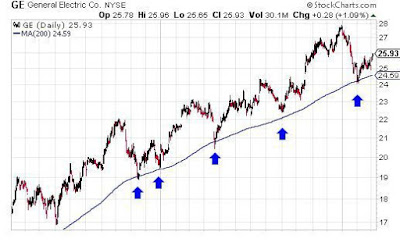One of the most popular indicators used by traders are Moving Averages. These help you
determine a stock’s direction and price strength. Price strength is how strong a price is
compared to its moving average and is determined by the distance between the
candlesticks and the moving average (Further being stronger price strength). Many traders
use a Moving Average as a way to determine when to buy and sell stocks. When
considering to buy a stock, traders will wait for confirmation, which is when the
candlesticks cross above a Moving Average and continue a trend above it. After riding this
trend up, they sell when the chart hits validation, or when the candlesticks pass below the
Moving Average and start trending below it. This strategy of confirmation/validation is
much more common with short-period Moving Averages, such as a 9-Period MA
Above, you can see an example of price strength and confirmation/validation. As you can see, the stock price starts to move faster as it gets further away from the Moving Average. Also, a stock starts to increase when it passes above the Moving Average and starts to decrease when it passes below the Moving Average. This indicates confirmation and validation, respectively.
Above, you can see an example of another use of a Moving Average, and that is when it acts as a
trend line. In this case, the Moving Average is acting as a line of support and is not allowing the price to drop below the Moving Average. This can allow for constant buying and selling to make profits.
How Do You Set Up a Moving Average?
When setting up a moving average, you will first be asked for the period, or the average
over a certain amount of time. Many traders utilize both short-period and long-period
moving averages that we will go further into when we talk about strategies. The second
parameter you will be asked for is the field, or which measure you want the moving
average to use (such as open, close, high, low, etc.). Nearly every trader uses “close” for
their field because it shows the true price after some movement. The next parameter will
be the type of moving average, with the two most common being exponential and simple.
The difference between Exponential Moving Average (EMA) and Simple Moving Average
(SMA) is the emphasis put on recent data points. EMAs put much more emphasis on recent
data points and are therefore used more for shorter-term trading, such as day trading,
while SMAs do not put this emphasis on recent data points and are therefore used more
for longer-term trading, such as swing trading and long-term investing. The final parameter
you might be asked for is the offset (which puts emphasis on the past or future), which
should be set to 0. Finally pick a color and your Moving Average is set up.
Now you should be able to efficiently set up, read, and use Moving Averages. Moving Averages are a very important part of many investor's strategies and is one of the most popular technical indicators. It is important to figure out how you personally like the set up a Moving Average and apply it to your strategy appropriately.

